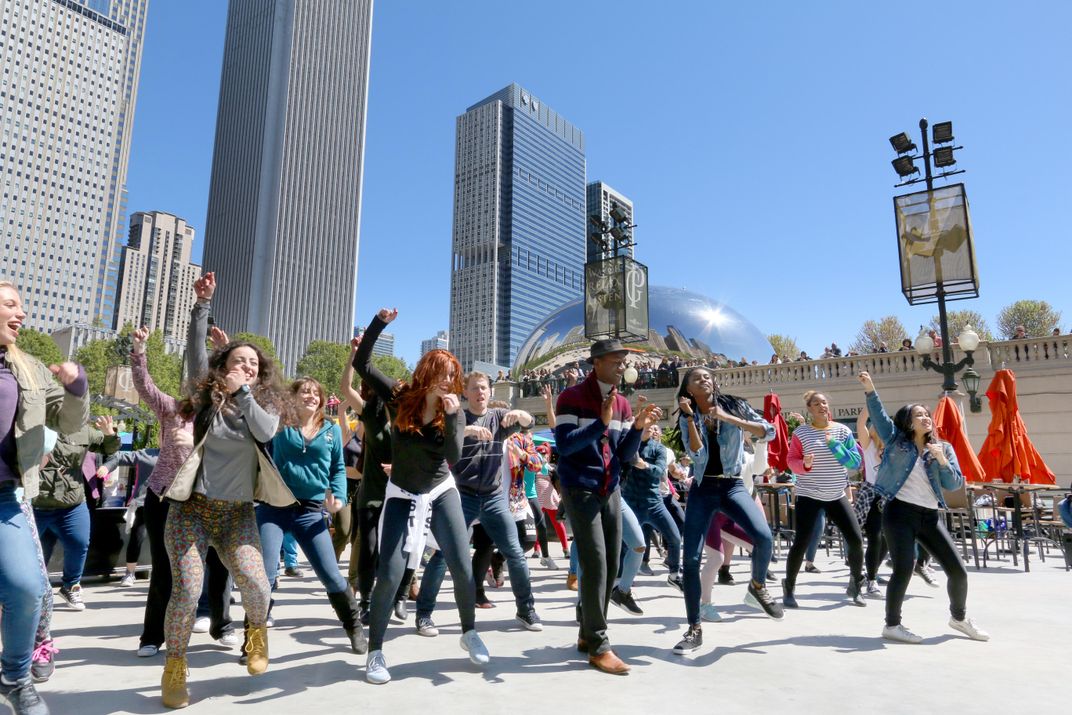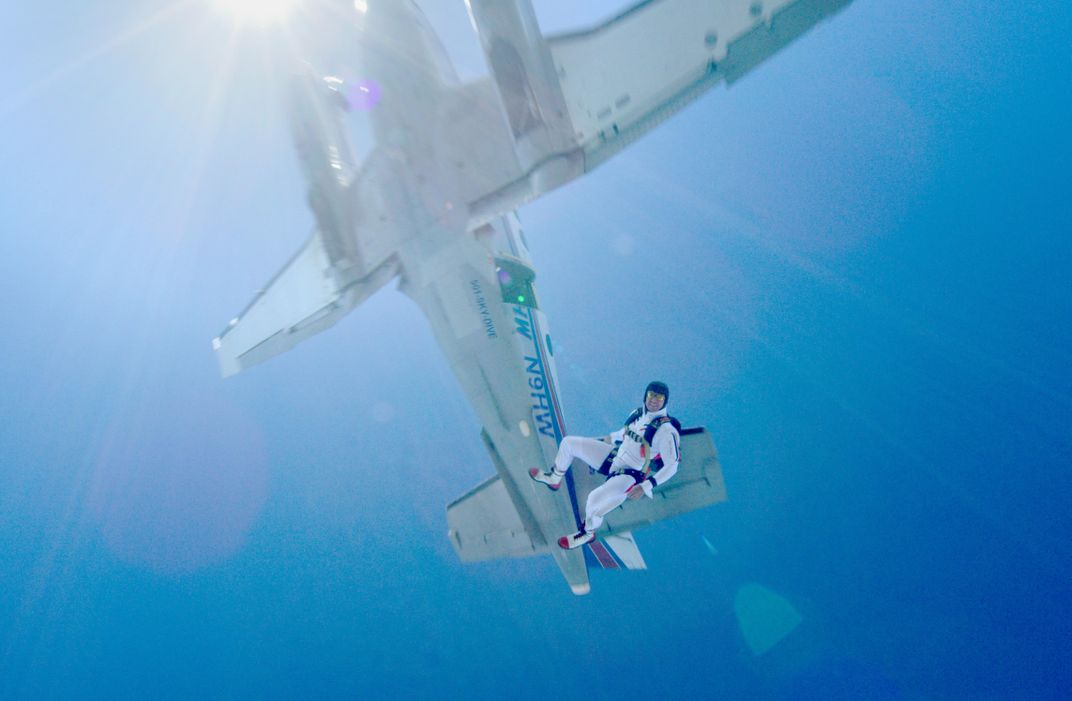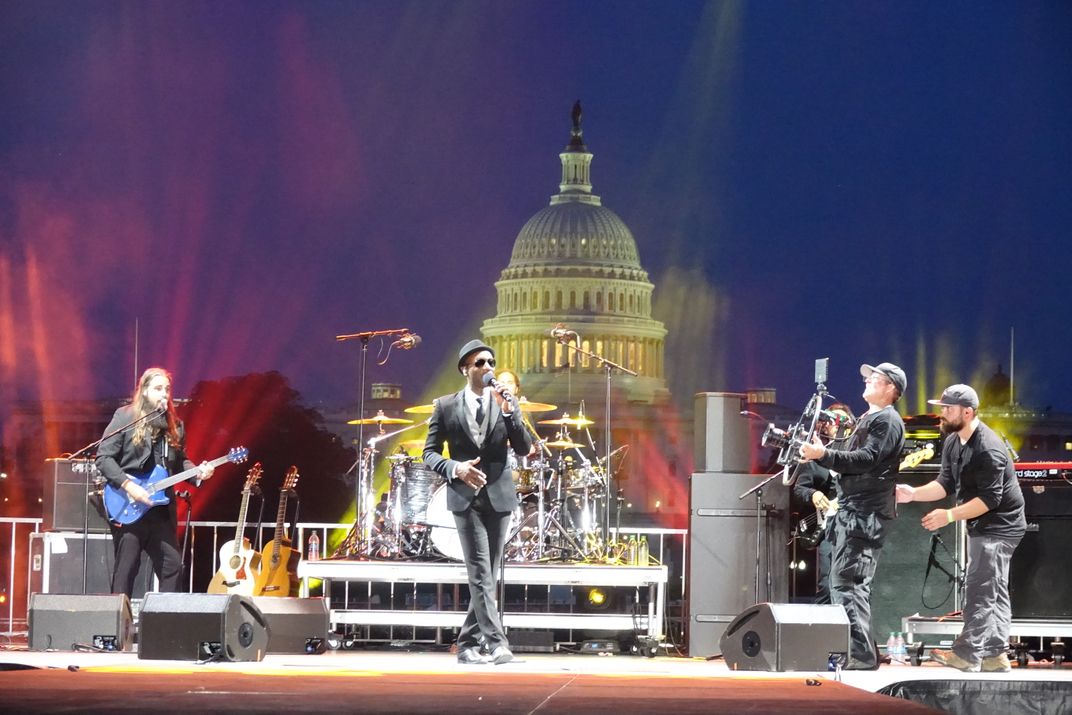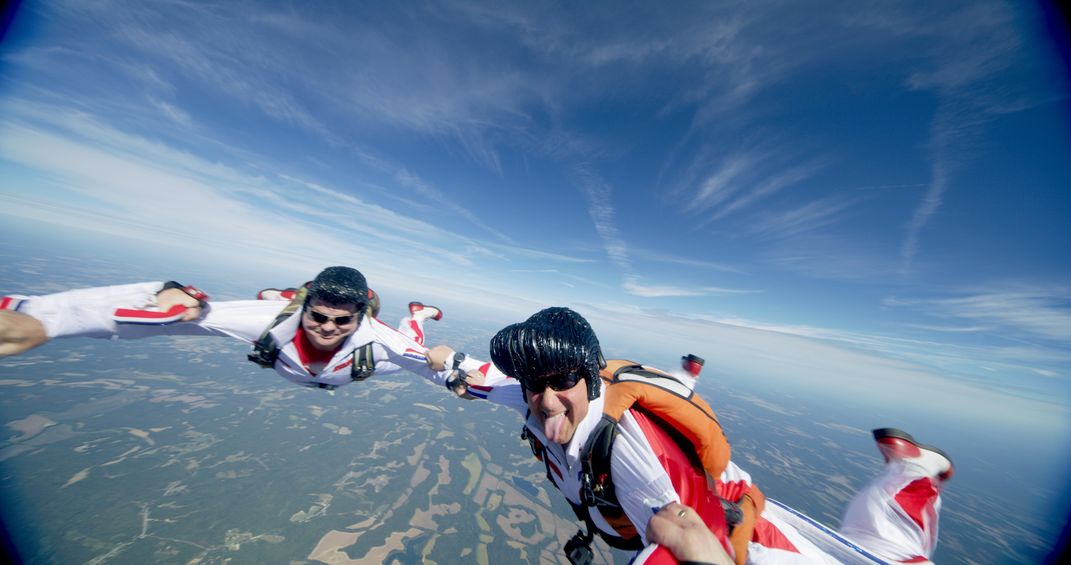Latest IMAX Film Studies History of American Music
Air and Space Museum makes way for the Flying Elvi
For more than 40 years, Greg MacGillivray has taken his oversize IMAX cameras to the top of Everest, into the eye of a hurricane and out in deepest space. With his latest IMAX feature America’s Musical Journey, though, he focuses on something more abstract: the sounds of one of the country’s greatest cultural exports.
Led by the recording artist Aloe Blacc, the film explores the roots of America’s music, from the jazz of New Orleans, to the twang of Nashville, the gospel, blues and rock ’n’ roll of Memphis, and finally the Latin spice of Miami.
Along the way, a flash mob dances in Chicago, there’s a gathering on the steps of Louis Armstrong’s former brick home in Queens, New York, and a concert last summer on Washington D.C.’s National Mall, steps from the Smithsonian’s National Air and Space Museum, where America’s Musical Journey recently opened, alongside Ryan Coogler’s critically acclaimed Black Panther and, oddly, MacGillivray’s first IMAX film for the museum, To Fly! which has been playing since 1978 when the museum first opened.
Back then the 70mm IMAX—short for Image Maximum—was a laborious process.
“The cameras were cruder,” says MacGillivray, 72. “In fact, when we started To Fly! there was only one camera. The second one that they built, got pushed out of an airplane to get a great shot on a parachute as it drifted toward the ground. But something happened and the parachute didn’t open, so it was destroyed.”
The Canadians who developed IMAX spent another year building a replacement camera. They affixed them to helicopters “to give the audience a sense of flying.”
That happens, too, in the musical film, where crisp, birds’s eye views capture glittering urban cityscapes of the various sites. Designed to be shown on large two-dimensional screens, but also in 3D and in IMAX domes, the aerial shots remain a visual highlight of the film.
Using film ten times the size of standard 35 mm, the first IMAX cameras were originally the size of a small refrigerator. “Two people could lift it but you had to put it on a big tripod, or a big dolly or a big crane or a big helicopter—not easy,” MacGillivray says. “To think today, you can almost do the same thing with a small video camera that weighs less than a couple of pounds.”
One IMAX camera was strapped on the chest of a skydiving member of the Flying Elvi, the Las Vegas troupe that dives while dressed in Elvis Presley jumpsuits and wigs.
Even with the aerial shots, skydiving and footage of a daredevil dance troupe that cavorts alongside skyscrapers, America’s Musical Journey is a decidedly different approach for MacGillivray, after his dozens of nature and adventure films.
“Because I always loved the connection of film and music, it was not only a challenge but a complete delight to make a movie that just centered around music, the history of music and Aloe Blacc and his personality and his music,” he says. “We still tried to wrap it with the feeling of being there—the feeling of being involved with a subject.”
As a tour guide, Blacc, 39, the Grammy-nominated performer behind hits like “I Need a Dollar.” who sang on Avicii’s “Wake Me Up,” was well suited. A first-generation American born to Panamanian parents, incorporates a lot of different styles into his music and interacts enthusiastically with other musicians he meets along the way, from Jon Batiste and Keb’ Mo’ to Ramsey Lewis and teenage banjoist Willow Osborne. In Miami, he gets advice on adding Latin flavor to one of his songs from Gloria and Emilio Estefan.
Staging the musical dance numbers in Chicago, Miami and Memphis were new things for MacGillivray, whose company is called MacGillivray Freeman in honor of his partner Jim Freeman, who was killed in a Sierra Nevada helicopter crash in 1976.
But the wide aerial shots of each city are something he knows well.
“Those were all shot with film cameras on a big helicopter,” he says. “What we do is we try to shoot right at dawn or right at dusk, where the light is low and beautiful, and try to shoot on days where the skies are absolutely clear of clouds, so you have a nice deep blue in the sky and it gives you that magical look of a city that almost looks miniature. You look down on it and it just looks crystal clear.”
It took two years to make America’s Musical Journey, mostly due to research done at places like the Smithsonian’s National Museum of African American History and Culture to the Louis Armstrong Museum in New York City. “We also had a musicologist from Duke University,” MacGillivray says. “The toughest thing fitting it into 40 minutes, and what we would have to leave out.”
Indeed, there are glimpses of American musical hotspots Detroit, Seattle, Austin, Minneapolis and Las Vegas, but not time to fully explore them.
“Unfortunately, we had to leave a lot out that we would love to have included,” the filmmaker says. “It would make a great two-hour music.”
The film does have the familiar booming voice of Morgan Freeman as narrator, though. He’s one of a long line of big name narrators for MacGillivray Freeman films.
“Our movies get shown to a lot of people,” MacGillivray says. “They don’t produce the kind of profits that a Hollywood film will produce obviously, but they show for a long time.
“So for a narrator, they’ll know their work is not only going to last maybe 10 years in the marketplace, but also they’re contributing to a movie that’s going to benefit the world in some way: it’s going to educate kids, it’s going to open eyes to new places and new opportunities, maybe it’s even going to shift a kid’s career choice and inspire a kid in a certain direction. So they like it. That’s why Meryl Streep has narrated three of our films, and Robert Redford has narrated a couple. Morgan Freeman, this is the first time we’ve been able to get him.”
It’s true that more and more Hollywood movies are getting into IMAX theaters these days, alongside his educational films, but those hits often help museums make the kind of revenue to keep their doors open, MacGillivray says. “The IMAX theater has in a way saved museums over the last 40 years. So I’m really proud of that and it continues today.”
And when America’s Musical Journeys begins its run at the IMAX Theaters this weekend, it will often be in places like the Air and Space Museums, that never stopped showing MacGillivray’s first film from 1976, To Fly!
“I love that.” MacGillivray says. “That’s great.”
“America’s Musical Journey” is on view at IMAX theaters worldwide, including, in 3D at the Lockheed IMAX Theater at the Smithsonian’s National Air and Space Museum through Sunday, February 25; and the Warner Bros. Theater at the American History Museum in Washington, D.C., and the Airbus IMAX Theater at the Steven F. Udvar-Hazy Center in Chantilly, Virginia. Check for ticket availability.
/https://tf-cmsv2-smithsonianmag-media.s3.amazonaws.com/accounts/headshot/RogerCatlin_thumbnail.png)








/https://tf-cmsv2-smithsonianmag-media.s3.amazonaws.com/accounts/headshot/RogerCatlin_thumbnail.png)